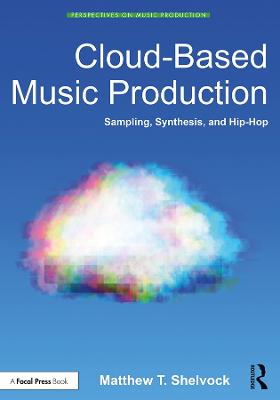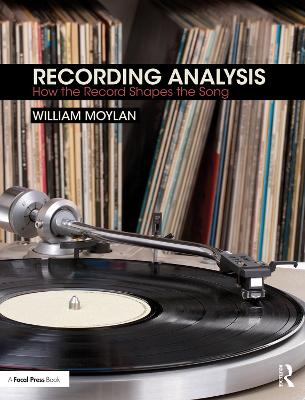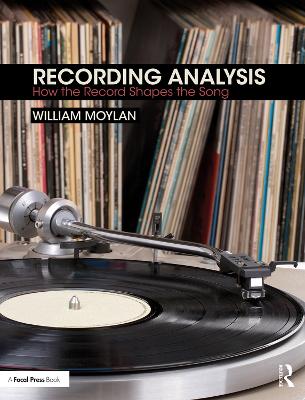Cloud-Based Music Production
 -10%
portes grátis
-10%
portes grátis
Cloud-Based Music Production
Sampling, Synthesis, and Hip-Hop
Shelvock, Matthew T.
Taylor & Francis Inc
02/2020
168
Dura
Inglês
9780815353188
15 a 20 dias
494
Descrição não disponível.
Introduction: Cloud-based Music Production (CBMP)
0.1 Defining Music Production
0.2 CBMP Services
0.3 Sound-Tagging and Search Filters
0.4 Project Backup and Sharing
0.5 Access to Professional Sounds
0.6 Free Tools/Rent-to-Own
0.7 Community, Contests, and Collaboration
0.8 Chapter Outline
Chapter 1: Understanding Samples, Synthesis, Editing, and Mixing
1.1 Virtual Performance: Performing Samples, Performing Synthesis
1.1.1 Performance Inputs: Sample Triggering, Synthesis, and MIDI
1.1.2 Point and Click Editing
1.2 Creating Hip Hop Sounds: Sampling
1.2.1 Technological Constraints, Sample Arrangement, and Sample Phrasing
1.2.2 Types of Samples: One Shots and Continuous Samples
1.2.3 Timbre and Arrangement
1.2.4 Categorizing Samples: Instrument Families as Conceptual Groups in Sample Arrangement
1.3 Synthesizers
1.3.1 Synthesizer Types
1.3.2 Synths in Modern Hip Hop
Chapter 2: Making Music Using CBMP Resources
2.1 Making Music from Samples
2.2 Drums, Percussion, Bass
2.2.1 Creating Drum and Percussion Tracks with One Shots: Timbral Selection and Arrangement
2.2.2 Rhythmic Congruence in Sampling: Using Continuous Samples for Additional Percussion
2.2.3 Hip Hop Microrhythm: Creating Intentional Rhythmic Incongruence
2.3 Bass
2.4 Melodic Sounds
2.4.1 Categorizing Short-to-Medium Length Melodic Samples: ADSR Profiles
2.4.2 Arranging Long Duration Melodic Samples
2.4.3 Arranging Commonly Used Short- to Medium Duration Melodic Sounds
2.5 Textures, Atmosphere, and Harmony
2.5.1 Ready-Made and Cloud-Based Textures and Atmospheric Samples
2.5.2 Custom Atmospheres and Textures
Chapter 3: The Mix - Conditioning Musical Materials on Records
3.1 What is Mixing?
3.2 Establishing Genre through Material Means
3.3 Spectral Distribution
3.4 Dynamic Contours
3.5 Stereo Configuration
3.6 Ambient Design
3.7 Noise, Distortion, Saturation, and Enhancement
Chapter 4: Hearing for Your Audience - Beat Production as a Psychoacoustic Art
4.1 Sonic Realism and The Canvas of Psychophysiology
4.2 Mixing Beats: Constructing Past Tense Aural Narratives
4.3 Painting on the Psychoacoustic Canvas: Applying Gestalt Theory to Mixing Technique
4.4 What is Gestalt Theory?
4.5 Auditory Stream Segregation and the Law of Disjoint Allocation
4.6 Laws of Similarity and Common Fate: Location, Timbre, and Signal Routing
4.7 The Figure-Ground Phenomenon: More Applications for Mix Buses
4.8 The Rule of Good Continuation: Parameter Automation and Low Frequency Oscillators
4.9 Chapter Summary
Chapter 5: Case Studies in CBMP
Case Study 1: "melancholy" by kingmobb (2019)
Case Study 2: "fayth" by kingmobb (2019)
Case Study 3: "Dxn't Want U" by kingmobb, from KNGMXBB II (2017)
Conclusions
0.1 Defining Music Production
0.2 CBMP Services
0.3 Sound-Tagging and Search Filters
0.4 Project Backup and Sharing
0.5 Access to Professional Sounds
0.6 Free Tools/Rent-to-Own
0.7 Community, Contests, and Collaboration
0.8 Chapter Outline
Chapter 1: Understanding Samples, Synthesis, Editing, and Mixing
1.1 Virtual Performance: Performing Samples, Performing Synthesis
1.1.1 Performance Inputs: Sample Triggering, Synthesis, and MIDI
1.1.2 Point and Click Editing
1.2 Creating Hip Hop Sounds: Sampling
1.2.1 Technological Constraints, Sample Arrangement, and Sample Phrasing
1.2.2 Types of Samples: One Shots and Continuous Samples
1.2.3 Timbre and Arrangement
1.2.4 Categorizing Samples: Instrument Families as Conceptual Groups in Sample Arrangement
1.3 Synthesizers
1.3.1 Synthesizer Types
1.3.2 Synths in Modern Hip Hop
Chapter 2: Making Music Using CBMP Resources
2.1 Making Music from Samples
2.2 Drums, Percussion, Bass
2.2.1 Creating Drum and Percussion Tracks with One Shots: Timbral Selection and Arrangement
2.2.2 Rhythmic Congruence in Sampling: Using Continuous Samples for Additional Percussion
2.2.3 Hip Hop Microrhythm: Creating Intentional Rhythmic Incongruence
2.3 Bass
2.4 Melodic Sounds
2.4.1 Categorizing Short-to-Medium Length Melodic Samples: ADSR Profiles
2.4.2 Arranging Long Duration Melodic Samples
2.4.3 Arranging Commonly Used Short- to Medium Duration Melodic Sounds
2.5 Textures, Atmosphere, and Harmony
2.5.1 Ready-Made and Cloud-Based Textures and Atmospheric Samples
2.5.2 Custom Atmospheres and Textures
Chapter 3: The Mix - Conditioning Musical Materials on Records
3.1 What is Mixing?
3.2 Establishing Genre through Material Means
3.3 Spectral Distribution
3.4 Dynamic Contours
3.5 Stereo Configuration
3.6 Ambient Design
3.7 Noise, Distortion, Saturation, and Enhancement
Chapter 4: Hearing for Your Audience - Beat Production as a Psychoacoustic Art
4.1 Sonic Realism and The Canvas of Psychophysiology
4.2 Mixing Beats: Constructing Past Tense Aural Narratives
4.3 Painting on the Psychoacoustic Canvas: Applying Gestalt Theory to Mixing Technique
4.4 What is Gestalt Theory?
4.5 Auditory Stream Segregation and the Law of Disjoint Allocation
4.6 Laws of Similarity and Common Fate: Location, Timbre, and Signal Routing
4.7 The Figure-Ground Phenomenon: More Applications for Mix Buses
4.8 The Rule of Good Continuation: Parameter Automation and Low Frequency Oscillators
4.9 Chapter Summary
Chapter 5: Case Studies in CBMP
Case Study 1: "melancholy" by kingmobb (2019)
Case Study 2: "fayth" by kingmobb (2019)
Case Study 3: "Dxn't Want U" by kingmobb, from KNGMXBB II (2017)
Conclusions
Este título pertence ao(s) assunto(s) indicados(s). Para ver outros títulos clique no assunto desejado.
Novation Launchpad;Played Back;Sonic Depth;Midi Data;Midi Controller;Dead Beats;Hip Hop Beats;Hip Hop Records;Kick Drum;Stereo Bus;Vocal Sample;Stereo Field;Hip Hop Production;Snare Drum;Fundamental Frequencies;Auditory Stream Segregation;Record Collectors;Figure Ground Phenomenon;Gestalt Law;Stereo Configuration;Auditory Stream;Midi Clip;Mix Engineers;Haas Effect;Midi Event
Introduction: Cloud-based Music Production (CBMP)
0.1 Defining Music Production
0.2 CBMP Services
0.3 Sound-Tagging and Search Filters
0.4 Project Backup and Sharing
0.5 Access to Professional Sounds
0.6 Free Tools/Rent-to-Own
0.7 Community, Contests, and Collaboration
0.8 Chapter Outline
Chapter 1: Understanding Samples, Synthesis, Editing, and Mixing
1.1 Virtual Performance: Performing Samples, Performing Synthesis
1.1.1 Performance Inputs: Sample Triggering, Synthesis, and MIDI
1.1.2 Point and Click Editing
1.2 Creating Hip Hop Sounds: Sampling
1.2.1 Technological Constraints, Sample Arrangement, and Sample Phrasing
1.2.2 Types of Samples: One Shots and Continuous Samples
1.2.3 Timbre and Arrangement
1.2.4 Categorizing Samples: Instrument Families as Conceptual Groups in Sample Arrangement
1.3 Synthesizers
1.3.1 Synthesizer Types
1.3.2 Synths in Modern Hip Hop
Chapter 2: Making Music Using CBMP Resources
2.1 Making Music from Samples
2.2 Drums, Percussion, Bass
2.2.1 Creating Drum and Percussion Tracks with One Shots: Timbral Selection and Arrangement
2.2.2 Rhythmic Congruence in Sampling: Using Continuous Samples for Additional Percussion
2.2.3 Hip Hop Microrhythm: Creating Intentional Rhythmic Incongruence
2.3 Bass
2.4 Melodic Sounds
2.4.1 Categorizing Short-to-Medium Length Melodic Samples: ADSR Profiles
2.4.2 Arranging Long Duration Melodic Samples
2.4.3 Arranging Commonly Used Short- to Medium Duration Melodic Sounds
2.5 Textures, Atmosphere, and Harmony
2.5.1 Ready-Made and Cloud-Based Textures and Atmospheric Samples
2.5.2 Custom Atmospheres and Textures
Chapter 3: The Mix - Conditioning Musical Materials on Records
3.1 What is Mixing?
3.2 Establishing Genre through Material Means
3.3 Spectral Distribution
3.4 Dynamic Contours
3.5 Stereo Configuration
3.6 Ambient Design
3.7 Noise, Distortion, Saturation, and Enhancement
Chapter 4: Hearing for Your Audience - Beat Production as a Psychoacoustic Art
4.1 Sonic Realism and The Canvas of Psychophysiology
4.2 Mixing Beats: Constructing Past Tense Aural Narratives
4.3 Painting on the Psychoacoustic Canvas: Applying Gestalt Theory to Mixing Technique
4.4 What is Gestalt Theory?
4.5 Auditory Stream Segregation and the Law of Disjoint Allocation
4.6 Laws of Similarity and Common Fate: Location, Timbre, and Signal Routing
4.7 The Figure-Ground Phenomenon: More Applications for Mix Buses
4.8 The Rule of Good Continuation: Parameter Automation and Low Frequency Oscillators
4.9 Chapter Summary
Chapter 5: Case Studies in CBMP
Case Study 1: "melancholy" by kingmobb (2019)
Case Study 2: "fayth" by kingmobb (2019)
Case Study 3: "Dxn't Want U" by kingmobb, from KNGMXBB II (2017)
Conclusions
0.1 Defining Music Production
0.2 CBMP Services
0.3 Sound-Tagging and Search Filters
0.4 Project Backup and Sharing
0.5 Access to Professional Sounds
0.6 Free Tools/Rent-to-Own
0.7 Community, Contests, and Collaboration
0.8 Chapter Outline
Chapter 1: Understanding Samples, Synthesis, Editing, and Mixing
1.1 Virtual Performance: Performing Samples, Performing Synthesis
1.1.1 Performance Inputs: Sample Triggering, Synthesis, and MIDI
1.1.2 Point and Click Editing
1.2 Creating Hip Hop Sounds: Sampling
1.2.1 Technological Constraints, Sample Arrangement, and Sample Phrasing
1.2.2 Types of Samples: One Shots and Continuous Samples
1.2.3 Timbre and Arrangement
1.2.4 Categorizing Samples: Instrument Families as Conceptual Groups in Sample Arrangement
1.3 Synthesizers
1.3.1 Synthesizer Types
1.3.2 Synths in Modern Hip Hop
Chapter 2: Making Music Using CBMP Resources
2.1 Making Music from Samples
2.2 Drums, Percussion, Bass
2.2.1 Creating Drum and Percussion Tracks with One Shots: Timbral Selection and Arrangement
2.2.2 Rhythmic Congruence in Sampling: Using Continuous Samples for Additional Percussion
2.2.3 Hip Hop Microrhythm: Creating Intentional Rhythmic Incongruence
2.3 Bass
2.4 Melodic Sounds
2.4.1 Categorizing Short-to-Medium Length Melodic Samples: ADSR Profiles
2.4.2 Arranging Long Duration Melodic Samples
2.4.3 Arranging Commonly Used Short- to Medium Duration Melodic Sounds
2.5 Textures, Atmosphere, and Harmony
2.5.1 Ready-Made and Cloud-Based Textures and Atmospheric Samples
2.5.2 Custom Atmospheres and Textures
Chapter 3: The Mix - Conditioning Musical Materials on Records
3.1 What is Mixing?
3.2 Establishing Genre through Material Means
3.3 Spectral Distribution
3.4 Dynamic Contours
3.5 Stereo Configuration
3.6 Ambient Design
3.7 Noise, Distortion, Saturation, and Enhancement
Chapter 4: Hearing for Your Audience - Beat Production as a Psychoacoustic Art
4.1 Sonic Realism and The Canvas of Psychophysiology
4.2 Mixing Beats: Constructing Past Tense Aural Narratives
4.3 Painting on the Psychoacoustic Canvas: Applying Gestalt Theory to Mixing Technique
4.4 What is Gestalt Theory?
4.5 Auditory Stream Segregation and the Law of Disjoint Allocation
4.6 Laws of Similarity and Common Fate: Location, Timbre, and Signal Routing
4.7 The Figure-Ground Phenomenon: More Applications for Mix Buses
4.8 The Rule of Good Continuation: Parameter Automation and Low Frequency Oscillators
4.9 Chapter Summary
Chapter 5: Case Studies in CBMP
Case Study 1: "melancholy" by kingmobb (2019)
Case Study 2: "fayth" by kingmobb (2019)
Case Study 3: "Dxn't Want U" by kingmobb, from KNGMXBB II (2017)
Conclusions
Este título pertence ao(s) assunto(s) indicados(s). Para ver outros títulos clique no assunto desejado.
Novation Launchpad;Played Back;Sonic Depth;Midi Data;Midi Controller;Dead Beats;Hip Hop Beats;Hip Hop Records;Kick Drum;Stereo Bus;Vocal Sample;Stereo Field;Hip Hop Production;Snare Drum;Fundamental Frequencies;Auditory Stream Segregation;Record Collectors;Figure Ground Phenomenon;Gestalt Law;Stereo Configuration;Auditory Stream;Midi Clip;Mix Engineers;Haas Effect;Midi Event







